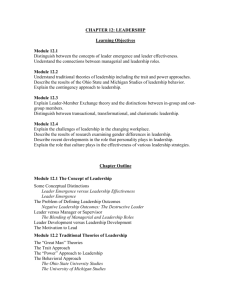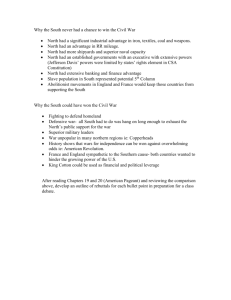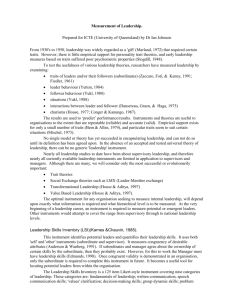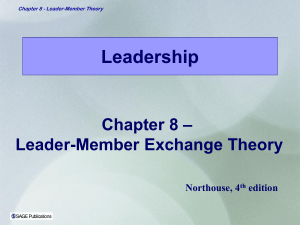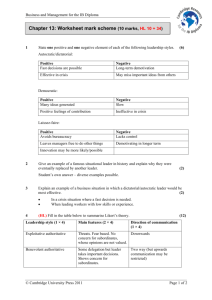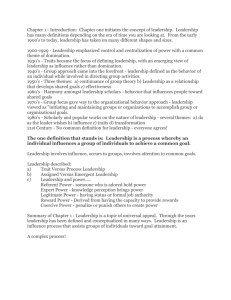RELATIONSHIP BETWEEN SUPERIOR
advertisement
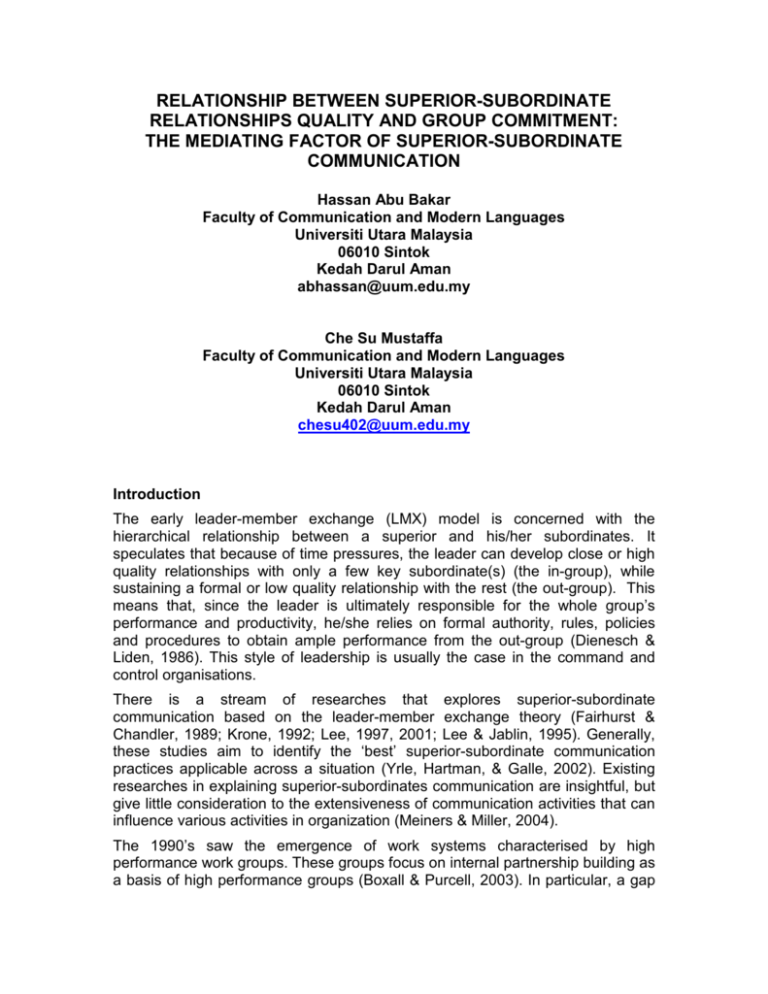
RELATIONSHIP BETWEEN SUPERIOR-SUBORDINATE RELATIONSHIPS QUALITY AND GROUP COMMITMENT: THE MEDIATING FACTOR OF SUPERIOR-SUBORDINATE COMMUNICATION Hassan Abu Bakar Faculty of Communication and Modern Languages Universiti Utara Malaysia 06010 Sintok Kedah Darul Aman abhassan@uum.edu.my Che Su Mustaffa Faculty of Communication and Modern Languages Universiti Utara Malaysia 06010 Sintok Kedah Darul Aman chesu402@uum.edu.my Introduction The early leader-member exchange (LMX) model is concerned with the hierarchical relationship between a superior and his/her subordinates. It speculates that because of time pressures, the leader can develop close or high quality relationships with only a few key subordinate(s) (the in-group), while sustaining a formal or low quality relationship with the rest (the out-group). This means that, since the leader is ultimately responsible for the whole group’s performance and productivity, he/she relies on formal authority, rules, policies and procedures to obtain ample performance from the out-group (Dienesch & Liden, 1986). This style of leadership is usually the case in the command and control organisations. There is a stream of researches that explores superior-subordinate communication based on the leader-member exchange theory (Fairhurst & Chandler, 1989; Krone, 1992; Lee, 1997, 2001; Lee & Jablin, 1995). Generally, these studies aim to identify the ‘best’ superior-subordinate communication practices applicable across a situation (Yrle, Hartman, & Galle, 2002). Existing researches in explaining superior-subordinates communication are insightful, but give little consideration to the extensiveness of communication activities that can influence various activities in organization (Meiners & Miller, 2004). The 1990’s saw the emergence of work systems characterised by high performance work groups. These groups focus on internal partnership building as a basis of high performance groups (Boxall & Purcell, 2003). In particular, a gap exists in identifying processes of communication exchanges in superiorsubordinate relationships (Kacmar, Witt, Zivnuska, & Gully, 2003; Olufowote, Miller, & Wilson, 2005). Therefore, this study addresses this concern by including the superior-subordinate communication as mediating variable that will affect the relationship between superior-subordinate relationships quality and group commitment. The need to develop this area of research is based on the urgency to gain a greater understanding about how relationship quality between superior and subordinate may differently influence organisational outcomes, such as group commitment, depending on communication activities between superior and subordinates. Kacmar, Witt, Zivnuska and Gully (2003) argued that the dynamic nature of the superior-subordinate relationships quality and communication relationship is not fully explored. Similarly, there is also a need to identify specific behaviours—that is, relationships between superior and subordinate and their interactions pattern—that can have greater impact on group commitment (Stinglhamber & Vandenberghe, 2003). Thus, the research outlined in this article can provide new insights into LMX relationships, superior-subordinate communication and commitment. Review of Literature and Hypotheses Development Leader-Member Exchange The leader-member exchange (LMX) model of leadership provides an approach to understanding the superior-subordinate relationship. Since its initial introduction, it has become one of the most popular conceptualisations and operationalizations of dyadic exchange between superior and his/her subordinates. LMX has established itself as a legitimate model and operationalizations for organizational behaviour research (Liden & Graen, 1980; Schriesheim, Castro, & Cogliser, 1999). In proposing this model, Graen and his colleagues (Dansereau, Graen, & Haga, 1975; Graen, 1976; Graen & Cashman, 1975) contested the traditional leadership approaches which assumed an Average Leadership Style (ALS) in leader behaviour across subordinates. They proposed that researchers always concentrate on the behaviours of leaders and subordinates within a superiorsubordinate dyad. Their work suggested that leaders do not have identical relationships across their subordinates in the work group, but develop unique dyadic relationships with each subordinate as a result of role making behaviour. High quality LMX dyads exhibit a high degree of exchange in superiorsubordinate relationships and are characterised by mutual liking, trust, respect, and reciprocal influence (Dienesch & Liden, 1986). Subordinates in these dyads are often given more information by the superior and report greater job latitude. Lower quality LMX relationships are characterised by a more traditional “supervisor” relationships based on hierarchical differentiation and the formal rules of the employment contract (Dansereau et al., 1975). In terms of superior behaviours, the distinction between higher and lower quality exchange relationships is similar to that of between “leadership” and “supervisor” respectively. Leaders exercise influence without sorting to formal authority, whereas supervisors rely on the formal employment contract for their authority. Early work on LMX provides support for the model’s theoretical propositions, including within group variance in superior behaviour. Graen and Cashman (1975) also found that superior-subordinate dyads can be grouped as high, medium, or low, demonstrating differential treatment by superior among subordinates. The model also demonstrated not only within group variation leader behaviour existed, but also that it was predictive of satisfaction to a greater degree than between group variations. Dienesch and Liden (1986) expanded the model developed by Graen and his colleagues. They detailed the development process within the context of the work group as a series of steps including the initial interaction between the superior and subordinates, superior delegation of a series of task assignments and responsibilities, member behaviour and attributions of the leader’s intentions (positive or negative) concerning the task assignments, and finally the superior’s attributions of the member’s behaviours and their subsequent response. The context includes the work group’s composition, the culture and policies of the organisation, and the power of the leader (Liden & Maslyn, 1998). Graen and Scandura (1987) argued that these work behaviours were paramount in the development of LMX as a uni-dimensional construct. LMX was posited as a multi-dimensional construct when Dienesch and Liden (1986) and Liden and Malsyn (1998) identified the potential for other “currencies of exchange” outside the work behaviours of superior and subordinates. This multidimensional approach to LMX has received a favourable support (Liden & Maslyn, 1993; Liden & Maslyn, 1998; Maslyn & Uhl-Bien, 2001). Currencies of exchange include affect, loyalty and/or professional respects between members, which can occur in varying amounts and combinations. Studies indicate that superiors and subordinates focus on different currencies of exchange from their partners. Superiors seek more work-related currencies, and subordinates seek more socially related currency (Day & Crain, 1992; Dockery & Steiner, 1990). A work-related currency is a perceived contribution, whereas the social currencies consist of affect, loyalty and professional respect. This study adopts the multidimensional view of LMX proposed by Dienesch and Liden (1986) and Liden and Maslyn (1998). Superior-Subordinate Communication The most important communication links within any organisation occur within superior-subordinate dyads. As the primary form of communication, a breakdown has fundamental implications for overall performance throughout the entire organisation (Clampitt & Downs, 1994; Downs et al., 1995). Superior-subordinate communication has been broadly defined as an exchange of information and influence among organisational members, one of whom has an official authority to direct and evaluate the activities of the subordinates of the organisation (Jablin, 1979). The quality of the superior-subordinate relationship is of crucial importance to the employees as well as the organisation because subordinates identify their immediate superior as the most preferred source of information about events in an organisation (Lee, 1997). In addition, employees identify their immediate superior as the primary source for receiving information from the top management (Lee, 2001). Jablin (1979) described superior-subordinate communication patterns as a form of work interactions in superior-subordinate relationships. He classified the superior-subordinate communication literature into nine categories including interaction patterns, openness in communication, upward distortion of information, the gap in understanding between superiors and subordinates, superior feedback, and the communication qualities of effective versus ineffective superiors. Jablin and Krone (1994) expanded superior-subordinate communication patterns beyond working interactions to include a component of social support in superiorsubordinate interactions. Social support is the communication between people who lend a hand, reassure, show concern for, and give encouragement between superior and subordinates (Meiners & Miller, 2004). This unique form of interaction reduces uncertainty, provides a sense of personal control, and creates a stronger bond between the superior and subordinates (Jablin & Krone, 1994; Lee, 2005; Lee & Jablin, 1995). In addition, social support can also serve as a defence to shield the negative consequences of stress brought on by organizational factors such as role ambiguity, work overload, and job uncertainty (Cohen, 1993). The most consistent finding in the social support research is that the immediate superior is the person most likely to provide this support and thus, reduce employees’ stress (Alexander, Helms, & Wilkins, 1989; Anderson & Tolson, 1991). In sum, communication is used as a process to obtain maximum resources from both superior and subordinates. This is affected through communication activities that include both work and social support interaction. Group Commitment The concept of commitment is one of the major factors in determining the relationship between individuals and an organisation (Mowday, Porter, & Steers, 1982). A review of the literature suggests that there are various distinct approaches to defining commitment. Commitment has been defined as a strong desire to maintain membership in an organisation (Mowday, Porter, & Steers, 1979). It has also been defined as identification with goals and values between an individual and the organisation (Buchanan, 1974) or an exchange of behaviour to get benefits that will be appreciated by others (Meyer & Allen, 1984). These definitions focus on the psychological relationships that individuals have with an organisation. Generally, scholars agree that the definition of commitment can be recognized through high involvement of the individual with an organisation; identification with the individual and organisation goals and values; exchange of behaviour to receive benefits, and psychological attachments of an individual to an organisation. Based on the definition given by Mowday, Porter and Steers (1982), many scholars have defined commitment thoroughly based on three factors, which are: belief and acceptance of values and organisational goals; willingness to exert individual effort to achieve organisational goals’; and a strong desire to maintain membership in an organisation (Meyer & Allen, 1991, 1997). It is important to recognise that organisations usually encompass many different constituencies that have their own group level goals. For example each group or unit in an organisation has its own goals to achieve. Therefore it is essential to specify the nature of these values and goals in order to predict subordinates’ behaviour at work such as commitment to the group (Reichers, 1985). The proposed study fills a gap in the literature in that it explores group commitment. Meyer and Allen (1991) identify three distinct themes in a definition of commitment: commitment as affective attachment to the organisation or group; commitment as a perceived cost associated with leaving the organisation or group, and commitment as an obligation to remain in the organisation or group. They refer to these constructs as affective commitment, continuance commitment, and normative commitment. They also argue that the nature of the psychological state for each form of commitment is quite different. Employees with strong affective commitment remain with the group because they want to, while those with strong continuance commitment remain because they need to, and those with a strong normative commitment remain in the group because they feel they have to do so. Hypotheses Communication within the superior-subordinate relationships has implications for the relationships between the persons and their peers working together on a group. Since co-workers are the most available and most frequent interactions sources in organization (Kramer, 1995, 2004). For example, Sias and Jablin (1995) found that differences in the quality of a superior’s communication exchanges with his or her subordinates have an impact with their co-worker. Coworkers are aware of the differential treatment and, in fact, talk about it. Furthermore, individuals in low versus high quality LMX relationships with their superior have more conversations about differential treatments with their peers. Sias (1996) also found that co-worker conversations about differential treatment by their superiors serve to create and reinforce social perceptions about differential treatment in the work group (Sias, 1996; Sias & Jablin, 1995). In term of communication impact on the group, Kramer (2004) argued that if the individual group members believe the preferential treatment to certain subordinate by superior is deserved, the entire group may benefit as they use that particular colleague to gain greater access and information from their superior. On the other hand, if individual within a workgroup resent the preferential treatment receive by some of their colleagues form their superior seems underserved, the workgroup may suffer collectively as the distance themselves from the high LMX colleagues and their superior. Therefore, in this article the superior-subordinate communication was considered as mediating factors for the relationship between superior-subordinate relationships quality and subordinate commitment to their group. Mediation exists when a predictor affects a dependent variable indirectly through at least one variable. Considering the argument by Kramer (2004) and pervious researchers for example Fairhurst (1989), Lee (1997, 2001). Different types of relationships quality between superior and subordinate will lead to different types of communication within the dyad. If the individual group members believe the preferential treatment and communication to certain subordinate by superior is deserved, the entire group may benefit as they use that particular colleague to gain greater access and information from their superior. On the other hand, if individual within a workgroup resent the preferential treatment and communication receive by some of their colleagues form their superior seems underserved, the workgroup may suffer collectively as the distance themselves from the high LMX colleagues and their superior. In supporting these ideas study by Walter, Anderson and Martin (2005) for example shows that communication motives in superior-subordinate relationships mediate the relationship between Machiavellianism and satisfaction with superiors. The model representing this idea is shown in Figure 1. Superior-Subordinate Communicationb (M) a Superior-Subordinate Relationships Quality (X) c Group Commitment (Y) Figure 1: The Mediation Model of Superior-Subordinate Relationships and Group Commitment Therefore, in the present study we speculated that superior-subordinate relationships quality should have a relationship to the group commitment but may also mediated by the superior-subordinate communication on the path to the group commitment. Thus, the following hypothesis were advanced: H: Superior-subordinate communication mediate the relationship between superior-subordinate relationship quality and group commitment. Method Respondents Respondents in this research are primarily managers, senior executives and executives in a corporation involved in aviation activities in Kuala Lumpur. The rationale for choosing this sample is that all senior executives and executives report to a specific manager in their respective work group. There are 14 unit managers (17.28%), 25 senior executives (30.86%) and 42 executives (51.86%). Measurement Instrument This study used the scale suggested by Liden and Maslyn (1998) for measuring superior-subordinate relationships quality, which consists of affect, loyalty, contribution and professional respect dimensions. Affect in this study refers to the mutual affection members of the dyad have for each other, based primarily on interpersonal attraction (Dienesch & Liden, 1986). Loyalty in this study refers to the expression of public support for the goals and the personal character of the other member of the LMX dyad (Dienesch & Liden, 1986). Perceived contribution in this study refers to perception of the current level of work-oriented activity each member puts toward the mutual goals (explicit or implicit) of the dyad (Dienesch & Liden, 1986). Professional respect in this study refers to the degree of perception to which each member of the dyad has built their reputation, within and/or outside the organisation, of excelling at his or her line of work (Liden & Maslyn, 1998). Miles, Patrick and King (1996) employed four separate dimensions of superiorsubordinate communication behaviours: positive relationship communication, upward openness communication, negative relationship communication and jobrelevant communication (Miles, Patrick, & King, 1996). This study uses the scale developed by Miles et al. (1996) mainly because these four dimensions according to Miles et al. (1996), generally represent superior-subordinate communication in the organisation, and have been shown to predict both subordinate’s job satisfaction and subordinate’s performance (Alexander et al., 1989). Positive relationships communication focuses on superiors seeking suggestions from subordinates, being interested in them as people, relating to them in casual manner, and allowing them to contribute input on important decisions (Miles et al., 1996). Upward openness communication is characterized by the opportunity to question a superior’s instruction and to disagree with a superior (Miles et al., 1996). Negative relationships communication deals with the superior ridiculing subordinates and criticizing them in the presence of others (Miles et al., 1996). Job-relevant communication includes a superior’s feedback on performances; information includes a superior’s feedback on performance, information about rules and policies, job instructions, work assignments and schedules, and goals (Miles et al., 1996). Meyer and Allen (1991) defined affective commitment as; ‘the relative strength of group member’s identification with and involvement in particular group’ and this item was labelled as Affective Commitment Scale. This scale is suggested by Allen and Meyer (1990). Another aspect of commitment is described as continuance that is defined as, ‘the group member feel lost if they were to leave the group, or if they recognize that the availability of comparable alternatives is limited’. Finally is the normative commitment, which is defined as, the ‘moral right to stay in the group regardless of how much status enhancement or satisfaction the organisation has given’. Measures of the three components of commitment are developed and found to be psychometrically sound (Allen, 1996; Allen & Meyer, 1990; Hartmann & Bambacas, 2000). Factor analytic studies of the affective, continuance and normative commitment scales have shown that they measure relatively distinct constructs (Hartmann & Bambacas, 2000; Shore & Tetrick, 1991). All the items are measured and operationalized using a 5-point Likert-type, ranging from strongly agree to strongly disagree. Table 1 shows the descriptive statistics and alpha for superior-subordinate relationships quality, superiorsubordinate communication and group commitment. Table 1 Descriptive Statistics, Correlations, and Reliabilities of Variables Variable M 1. Superior-subordinate relationships quality SD α 1 2 3.94 .531 .87 (1) 2. Superior-subordinate communication 4.07 .478 .83 .51* (2) 3. Group Commitment 3.85 .732 .76 .409* .480* 3 (3) *Significance at 0.01 Procedures The proposed research addresses the concern over common source variance or common ratter effects in measuring leader-member exchange, superiorsubordinate communication and group commitment constructs. It does this in three ways. Firstly, it obtains measures of the predictor and criterion variables from different sources. This is achieved through obtaining an understanding of leader-member exchange and superior-subordinate communication practices constructs from subordinate’s perspectives via a questionnaire. While the group commitment construct were obtained from superior. Therefore, superior rated all his/her subordinate’s commitment to the group. Secondly, this study takes an average rating of these constructs from the superior’s and subordinate’s perspectives. The average rating of these constructs then will be compared to how LMX, superior-subordinate communication practices and group commitment are viewed and measured in the literature. Finally, we employ time lag in obtaining data for LMX, superior-subordinate communication and group commitment. In doing these three sessions of questions and answers of the constructs are conducted. These three approaches are commonly applied to minimise the common source variance in cross-level studies (Podsakoff, Mackenzie, Lee, & Podsakoff, 2003). Results Baron and Kenny (1986) proposed a four-steps to statistical mediation analysis, in which several analyses are conducted and the significance of the coefficients is examined at each step. According to Baron and Kenny (1986), a variable functions as a mediator when it meets the following conditions: First, the variation in levels of the independent variable significantly account for variations in the presumed mediator (path a in Figure 1). Second, the variations in the mediator significantly account for variations in the dependent variable (path b in Figure 1). Finally, when path a and b in Figure 1 are controlled, a previously significant relation between the independent and dependent variables is no longer significant, with the strongest demonstration of mediation occurring when path c in Figure 1 is zero. However, if path c is not zero, this indicates the operation of multiple mediating factors known as partial mediation. Following Baron and Kenny (1986) approaches, we conducted four steps of regression analysis. In first step we conduct a simple regression analysis with X predicting Y to test for path c in Figure 1 alone. Y = i + cX + e Where Y is group commitment, i is an intercept and c denotes unstandardized sample estimates of regression coefficients in Figure 1, and e is residual. The first step is to establish presence of a total effect (c). Our analysis shows Group Commitment = 34.53 + .637(Superior-Subordinate Relationships Quality). We found c = .637, p = .0001 from first equation. Second, we conduct a simple regression analysis with X predicting M to test for path a alone in Figure 1. M = i + aX + e Where M is superior-subordinate communication, i is an intercept and a denotes unstandardized sample estimates of regression coefficients in Figure 1, and e is residual. Our analysis shows Superior-Subordinate Communication = 40.61 + .609(Superior-Subordinate Relationships Quality). We found c = .609, p = .0001 from second equation. Third, we conduct a simple regression analysis with M predicting Y to test the significance of path b alone in Figure 1. Y = i + bM + e Where Y is group commitment, i is an intercept and b denotes unstandardized sample estimates of regression coefficients in Figure 1, and e is residual. Our analysis shows Group Commitment = 21.17 + .627(Superior-Subordinate Communication). We found c = .609, p = .0001 from third equation. Finally, we conduct a multiple regression analysis with X and M predicting Y. Y = i + aX+ bM + e Where Y is group commitment, i is an intercept and a and b denote unstandardized sample estimates of regression coefficients in Figure 1, and e is residual. Our analysis shows Group Commitment = 15.05 + .345(SuperiorSubordinate Relationships Quality) + .480(Superior-Subordinate Communication). We found a = .345 with p = .52 and b = .480 with p = .002 from fourth equation. The direct effect of superior-subordinate relationships quality on group commitment from the fourth equation is smaller than the equation in first step and statistically not significant (p=.52). According to Baron and Kenny’s (1986), this pattern indicates a full mediation model. In other words, superiorsubordinate communication accounts for the relationship between superiorsubordinate relationships quality and group commitment. Discussion This study suggests that superior-subordinate communication behaviour plays an important role in affecting the relationship between superior-subordinate relationships quality and group commitment. As can be seen in our analyses, superior-subordinate act as mediating variable in influencing the relationship between superior-subordinate relationships quality and group commitment. This finding shows an important aspect of communication behaviour and LMX. As noted by Yrle et al. (2002), when subordinates perceive that they are in higherquality exchange relationships, they will also report that their supervisor coordinates (in a two-way fashion) their activities and that they have increased ability to participate. This in-turn will influence their commitment to the group. The current findings suggest that subordinates perceive that they are in higher-quality exchange relationships. Thus, current study indicates that if superior seeks suggestions from their subordinates, are interested in them as people, relate to them in a casual manner, and allow them to contribute input on important decisions in order to maintain their working relationship, it will consequently affect their commitment to their work group. In other words, if a superior increases his or her communication behaviour (positive relationship communication, upward openness communication, negative relationship communication, and job-relevant communication) towards a subordinate, it will also increase his or her relationship from a low quality relationship to a high quality relationship with the subordinates and this will indirectly increase their commitment to the workgroup. Thus, hypothesis advanced in this study were accepted. Our findings support the proposition by communication scholars that the dyadic activities within a group does a effect the overall group behaviour (Kacmar et al., 2003; Kramer, 2004; Lee, 2005). Results of this study indicate that superiorsubordinate communication mediate the relationship between superiorsubordinate relationships quality and group commitment. Study among Malaysian employees has indicated that they show a strong desire to achieve group goals rather than their individual goals (Tuan, 1998). As such, the superiorsubordinate communication acting as mediation variable is relevant in Malaysian organization setting, because Malaysian employees display a strong humane orientation in their interaction within a society (Asma, 1992) that respects hierarchical differences and gives priority to maintaining harmony within a group (Kennedy, 2002). Conclusions and Limitations Findings reported in this study have important practical and theoretical implications that extend LMX theory. LMX theory suggests that superiors are largely responsible for the development of their superior-subordinate exchange relationships (Danserau, Graen, & Haga, 1975; Danserau & Markham, 1987; Graen & Scandura, 1987; Graen & Uhl-Bien, 1995). Accordingly, superiors can strongly influence types of communication experiences that the subordinates will have by developing and sustaining different LMX relationships and thus, are primarily responsible for the subordinates’ affective responses to them. Therefore, to improve effective communication among their subordinates, a superior could offer opportunities to develop and maintain higher-quality LMX relationships with as many subordinates as possible and simultaneously will improve group effectiveness collectively (Kramer, 2004; Mueller & Lee, 2002). For example a superior can increase communication quality through seeking feedback on jobs done by subordinates. A superior could also facilitate more upward communication and open communication with all subordinates regardless of their relationship quality or cultural background. Although our study supports LMX and communication research there are at least three limitations in the current study. First, sample size in this study was small and there were possibilities of different outcomes in actual study. Secondly, this study was conducted in an organization that has direct involvement with the Malaysian government. Future research could also consider conducting a study in a multinational corporation (MNC) or private organization in Malaysia. Such study can explore whether comparisons between government and private organizations will help us to better understand the dynamic relationship between LMX, communication and group behaviors. Thirdly, the analysis of mediation employed in this study has some limitations. Baron and Kenny (1986) approach was criticized on the grounds that it did not consider the estimate of the indirect effect, nor there was a standard error for this effect that might permit direct investigation of statistical significance. Therefore, future study should also consider adopting approach proposed by Shrout and Bolger (2002) through bootstrap framework and structural equation modeling in testing mediation model. In sum, the evidence of LMX theory and relationship communication patterns based on the Malaysian country context in this study improve our fundamental understanding of LMX, communication and group commitment. Results from this study further extend LMX-communication and in within group behaviors. The result suggests that superior-subordinate communication indirectly affect the relationship between LMX quality and group behaviors. Result of this finding also further support that in Malaysian organization setting there is greater emphasis on collective culture—this result suggests that the quality of the relationship between superior and subordinate will have an impact on communication and inturn will affect individual commitment to the group. This finding further emphasizes the importance of communication behavior to an effective work group. We hope that our study may contribute to universal understanding of LMX and superior-subordinate communication in two ways: i. ii. The model employed in the current study may serve as a comprehensive and meaningful understanding of leader-member exchange quality and group behavior. A supervisor as an agent of a system may be as important as an organization in influencing employees’ perceptions. In any organization, regardless of the context of institutionalism, a supervisor may still be psychologically and physically more proximal to employees, than the impersonal system. In turn, employees’ attitude towards a supervisor will have stronger impact on interpersonal communication than employees’ attitude towards overall communication system in organization. Results of this event will eventually improve individual group member commitment to the group. Reference Alexander, E. R., Helms, M. M., & Wilkins, R. D. (1989). The relationship between supervisory communication and subordinate performance and satisfaction among professionals. Public Personnel Management, 18(4), 415-428. Allen, M. W. (1996). The relationship between communication, affect, job alternatives, and voluntary turnover intentions. The Southern Communication Journal, 61(3), 198-210. Allen, N. J., & Meyer, J. P. (1990). The measurement and antecedents of affective, continuance and normative commitment to the organization. Journal of Occupational Psychology, 63(1), 1-18. Anderson, L. R., & Tolson, J. (1991). Leaders' upward influence in the organization: Replication and extensions of the Pelz Effect to include group-support and self-monitoring. Small Group Research, 22(1), 59-75. Asma, A. (1992). The influence of ethnic values on managerial practices in Malaysia. Malaysian Management Review, 27(1), 3-18. Baron, R. M., & Kenny, D. A. (1986). The moderator-mediator variable distinction in social psychological research: Conceptual, strategic, and statistical considerations. Journal of Personality and Social Psychology, 51(6), 11731182. Boxall, P. F., & Purcell, J. (2003). Strategy and human resource management. New York: Palgrave MacMillan. Buchanan, B. (1974). Building organizational commitment: The socialization of managers in work organizations. Administrative Science Quarterly, 19(4), 533-546. Clampitt, P. G., & Downs, C. W. (1994). Employee perceptions of the relationship between communication and productivity: A field study. Journal of Business Communication, 30(1), 5-29. Cohen, A. (1993). Organizational commitment and turnover: A meta-analysis. Academy of Management Journal, 36(5), 1140. Danserau, F., Graen, G. B., & Haga, W. (1975). A vertical dyad linkage approach to leadership within formal organizations: A longitudinal investigation of the role-making process. Organizational Behaviour and Human Performance, 18, 147-167. Danserau, F., & Markham, S. E. (1987). Superior-subordinate communication. In L. Porter (Ed.), Handbook of organizational communication (pp. 343-388). Beverly Hills, CA: Sage Publications. Dansereau, F., Graen, G., & Haga, W. J. (1975). A vertical dyad linkage approach to leadership within formal organizations: A longitudinal investigation of the role making process. Organizational Behaviour and Human Performance, 13(1), 46-78. Day, D. D., & Crain, E. C. (1992). The role of affect and ability in initial exchange quality perceptions. Group & Organization Studies, 17, 380-397. Dienesch, R. M., & Liden, R. C. (1986). Leader-member exchange model of leadership: A critique and further development. Academy of Management Review, 11(3), 618-634. Dockery, T. M., & Steiner, D. D. (1990). The role of the initial interaction in leader-member exchange. Group & Organization Studies, 15(4), 395-413. Downs, C. W., Downs, A., Potvin, T., Varona, E., Gribas, J. S., & Ticehurst, W. (1995, May). A cross-cultural comparison of relationship between organizational commitment and organizational communication. Paper presented at the International Communication Association Convention, Albuquerque, NM. Fairhurst, G. T., & Chandler, T. A. (1989). Social structure in leader-member interaction. Communication Monographs, 56(3), 215-239. Graen, G. B. (1976). Role-making processes within complex organizations. In M. D. Dunnette (Ed.), Handbook of industrial and organizational psychology (pp. 1201-1245). Chicago: Rand McNally. Graen, G. B., & Cashman, J. (1975). A role-making model of leadership in organizations: A development approach. In J. G. Hunt & L. L. Larson (Eds.), Leadership frontiers (pp. 143-165). Kent OH: Kent State University Press. Graen, G. B., & Scandura, T. A. (1987). Toward psychology of dyadic organizing. In S. B. M & L. L. Cummings (Eds.), Research in organizational behaviour (Vol. 9, pp. 175-208). Greenwich, CT: JAI Press. Graen, G. B., & Uhl-Bien, M. (1995). Relationship-based approach to leadership: Development of leader-member exchange (LMX) theory of leadership over 25 years: Applying a multi-level multi-domain perspective. Leadership Quarterly, 6(2), 219-247. Hartmann, L. C., & Bambacas, M. (2000). Organizational commitment: A multi method scale analysis and test of effects. International Journal of Organizational Analysis, 8(1), 89-108. Jablin, F. M. (1979). Superior-subordinate communication: The state of art. Psychological Bulletin, 86(9), 1201-1222. Jablin, F. M., & Krone, K. J. (1994). Task/work relationship: A life-span perspective. In M. L. Knapp & G. R. Miller (Eds.), Handbook of interpersonal communication (2nd ed., pp. 621-675). Beverly Hills, CA: Sage. Kacmar, K. M., Witt, L. A., Zivnuska, S., & Gully, S. M. (2003). The interactive effect of leader-member exchange and communication frequency on performance ratings. Journal of Applied Psychology, 88(4), 764-772. Kennedy, J. C. (2002). Leadership in Malaysia: Traditional values, international outlook. Academy of Management Executive, 16(3), 15-26. Kramer, M. W. (1995). A longitudinal study of superior-subordinate communication during job transfer. Human Communication Research, 22(1), 39-64. Kramer, M. W. (2004). The complexity of communication in leader-member exchanges. In G. Graen (Ed.), New frontiers of leadership. A volume in LMX leadership: The series (pp. 167-191). Greenwich, Connecticut: Information Age Publishing. Krone, K. J. (1992). A comparison of organizational, structural, and relationship effects on subordinates' upward influence choices. Communication Quarterly, 40(1), 1-15. Lee, J. (1997). Leader-member exchange, the 'Pelz effects' and cooperative communication between group members. Management Communication Quarterly, 11(2), 266-287. Lee, J. (2001). Leader-member exchange, perceived organizational justice, and cooperative communication. Management Communication Quarterly, 14(4), 574-589. Lee, J. (2005). Communication as antecedents and consequences of LMX development globally: A new strong inference approach. In G. Graen & J. A. Graen (Eds.), Global organizing designs. A volume in LMX leadership: The series (pp. 1-41). Greenwich, Connecticut: Information Age Publishing. Lee, J., & Jablin, F. M. (1995). Maintenance communication in superiorsubordinate work relationship. Human Communication Research, 22(2), 220-258. Liden, R. C., & Graen, G. B. (1980). Generalizability of the vertical dyad linkage model of leadership. Academy of Management Journal, 23(3), 451-465. Liden, R. C., & Maslyn, J. M. (1993). Scale development of a multidimensional measure of leader-member exchange. Paper presented at the Academy of Management, Atlanta, GA. Liden, R. C., & Maslyn, J. M. (1998). Multidimensionality of leader-member exchange: An empirical assessment through scale development. Journal of Management, 24(1), 43-73. Maslyn, J. M., & Uhl-Bien, M. (2001). Leader-member exchange and its dimensions: Effects of self effort and other's effort on relationship quality. Journal of Applied Psychology, 86(4), 697-708. Meiners, E. B., & Miller, V. D. (2004). The effect of formality and relational tone on supervisor-subordinate negotiation episodes. Western Journal of Communication, 68(3), 302-321. Meyer, J. P., & Allen, N. J. (1984). The measurement and antecedents of affective, continuance and normative commitment to the organization. Journal of Occupational Psychology, 63(3), 1-18. Meyer, J. P., & Allen, N. J. (1991). A three-component conceptualization of organizational commitment. Human Resource Management Review, 1(1), 61-89. Meyer, J. P., & Allen, N. J. (1997). Commitment in the workplace: Theory, research, and application. Thousand Oaks, CA: Sage. Miles, E. W., Patrick, S. L., & King, W. C. (1996). Job level as systematic variable in predicting the relationship between supervisory communication and job satisfaction. Journal of Occupational and Organizational Psychology, 69(3), 277-289. Mowday, R. T., Porter, L. W., & Steers, R. M. (1979). The measurement of organizational commitment. Journal of Vocational Behaviour, 14(4), 224247. Mowday, R. T., Porter, L. W., & Steers, R. M. (1982). Employee-organizational linkages: The psychology of commitment, absenteeism and turnover. New York: Academic Press. Mueller, B. H., & Lee, J. (2002). Leader-member exchange and organizational communication satisfaction in multiple context. Journal of Business Communication, 39(1), 220-244. Olufowote, J. O., Miller, V. D., & Wilson, S. R. (2005). The interactive effects of role change goals and relational exchanges on employee upward influence tactics. Management Communication Quarterly, 18(3), 385-403. Podsakoff, P. M., Mackenzie, S. B., Lee, J. Y., & Podsakoff, N. P. (2003). Common method biases in behavioral research: A critical review of the literature and recommended remedies. Journal of Applied Psychology, 88(5), 879-903. Reichers, A. E. (1985). A review and reconceptualization of organizational commitment. Academy of Management Review, 10(3), 465-476. Schriesheim, C. A., Castro, S. L., & Cogliser, C. C. (1999). Leader-member exchange (LMX) reserach: A comprehensive review of theory, measurement, and data-analytic practices. Leadership Quarterly, 10(1), 63-113. Shore, L. M., & Tetrick, L. (1991). A construct validity study of the survey of perceived organizational support. Journal of Applied Psychology, 76(5), 637-643. Shrout, P. E., & Bolger, N. (2002). Mediation in experimental and nonexperimental studies: New procedures and recommendations. Psychological Methods, 7(4), 422-445. Sias, P. M. (1996). Constructing perceptions of differential treatment: An analysis of co-worker discourse. Communication Monographs, 63(2), 171-187. Sias, P. M., & Jablin, F. M. (1995). Differential superior-subordinate relations, perceptions of fairness, and co-worker communication. Human Communication Research, 22(1), 5-38. Stinglhamber, F., & Vandenberghe, C. (2003). Organizations and supervisors as sources of support and targets of commitment: A longitudinal study. Journal of Organizational Behavior, 24(3), 251-270. Tuan, T. B. (1998). Participation of women in the labour force and need for child care services: A comparative study of Japan and Malaysia. In S. Z. S. Hassan (Ed.), Malaysian Women in the wake of change (pp. 61-73). Kuala Lumpur: University of Malaya. Yrle, A. C., Hartman, S. J., & Galle, W. P. (2002). An investigation of relationship between communication style and leader-member exchange. Journal of Communication Management, 6(3), 257-269. Yrle, A. C., Hartman, S. J., & Galle, W. P. (2003). Examining communication style and leader-member exchange: Considerations and concerns for managers. International Journal of Management, 20(1), 92-97.


